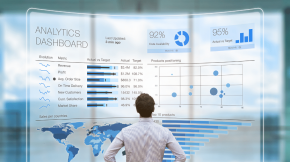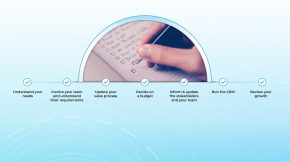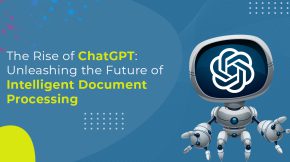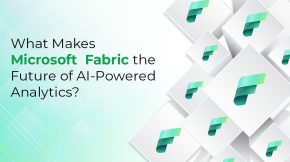How Does Data Analytics Boost Nonprofits?
Everywhere we look, data is present. There is data being used even as you read this blog. To put it into perspective, the planet contains about 400,000 bytes of data for each grain of sand. Humans are using data to make better decisions in every sector of society now more than ever. And data analytics is revolutionizing how we interpret this already-existing data. Data analytics as a holy grail is used in every industry, from improvements in healthcare to sports team tactics. But what about data analytics for nonprofits?
Data Analytics For Nonprofits: A Perfect Bond
The competition between nonprofits having similar missions and purposes increases as the nonprofit sector expands and thrives. Many nonprofit organizations experience growing discomforts as they aim to retain more valuable donors who frequently give as they develop over time. If you’re a nonprofit looking to achieve that goal, you need to strengthen your bonds with your supporters and provide them with better services. But how? With data analytics!
Understanding your supporters’ interests, preferences, and behaviors is possible by having useful data about them. Consider sending email and direct mail appeals as an example. According to the data from both channels, email appeals are more effective at looking for supporters to help your cause and raise money for it. You send more email appeals going forward and spend less money on the less effective communication channel because you have concrete proof that your supporters prefer email communication. That is one of the many ways how data analytics powers nonprofits.
Let’s talk about a few reasons why data analytics can benefit your nonprofit.
4 Data Analytics Types That Are Beneficial To Nonprofit Organizations
Every nonprofit’s daily operations include making decisions and solving problems. Imagine being able to reduce both the time and effort necessary to complete them. To do this, what if I told you that you only required the correct data?
Analytical tools won’t replace your ability to think intuitively. The core of nonprofit work has always been and will continue to be years of experience and interpersonal connections. Data analytics, however, can serve as a compass for you and your business. It can assist in reviewing campaign performance, enhancing donor communications, and boosting productivity.
Data has the potential to be a practical addition to your work, giving you the information you need to make wiser choices. These data analytics types benefit nonprofits massively.
1. Analytics Of Projections
- Identifies trends in data to predict future outcomes.
- Can aid in resource allocation and budgetary adjustments.
2. Digestive Analytics
- Draws connections between the variables while analyzing various data to shed light on why something occurred.
- May respond to inquiries about external factors, campaign effectiveness, etc.
3. Detailed Analytics
- Provides a thorough look at events that occurred during a specific time.
- Provides information on changes and complete comparison between two points in time.
4. Constructive Analytics
- Predicts outcomes and suggests actions using machine learning.
- Improves perceptions of the risks and advantages of specific actions by allowing nonprofits to encourage potential outcomes.
Why Use Data Analytics for Nonprofits?
In the bustling world of nonprofits, data analytics is more than just a trend – it’s a lifeline. It’s about turning raw data into meaningful insights that can propel your organization forward. Here’s why data analytics is indispensable for your nonprofit:
- Boosting Supporter Engagement: Data analytics can reveal patterns and trends in your supporters’ behavior, helping you to optimize your outreach efforts and strengthen your relationships with them.
- Enhancing Fundraising Efforts: By analyzing the success of past campaigns, you can fine-tune your strategies to maximize the impact of your fundraising efforts.
- Ensuring Accountability: Data analytics can provide transparency and evidence of your nonprofit’s impact, which is crucial for maintaining trust with your supporters, stakeholders, and the communities you serve.
- Forecasting Future Campaigns: Leveraging predictive analytics can help you anticipate future trends and prepare your organization to seize new opportunities.
However, to unlock the full potential of data analytics, it’s crucial to focus on the right metrics, establish a robust process for data collection and analysis, and maintain data accuracy and consistency. By doing so, your nonprofit can navigate challenges more effectively and amplify its impact.
Data Analytics For Nonprofits: A Closer Look at Key Metrics
Let’s walk through some crucial data metrics and see how they can revolutionize the way your nonprofit operates.
Social Media: Social media platforms significantly enhance nonprofits’ reach and visibility, facilitating volunteer attraction and pro bono consultations. Platforms like Facebook, Instagram, Twitter, and LinkedIn provide unique tools for fundraising and awareness drives. By understanding each platform’s features and audience, nonprofits can optimize their content and strategies. Tracking metrics like reach, engagement, and conversions allows for strategy refinement, making social media an effective tool for achieving nonprofit goals.
Email Analytics: Email isn’t just a communication tool, it’s your nonprofit’s engagement powerhouse! With email analytics, you can understand and inspire your supporters more effectively. Monitor key metrics like open rates and click-throughs to fine-tune your messaging and calls-to-action. It’s not just about sending emails; it’s about sparking meaningful interactions and driving action for your cause. So, let’s turn data into insight and emails into impactful conversations. Your mission deserves it!
Fundraising and Donor Analytics: This is where you delve into the heart of what drives your supporters. Imagine being able to identify trends in donation frequency or amounts. Or better yet, understanding your donor retention rate to tailor your communication and recognition strategies to keep your supporters feeling valued and engaged.
Business and Financial Analytics: These metrics serve as the health check for your nonprofit. They help you track revenue and expenditures, ensuring your nonprofit stays financially healthy and sustainable. More importantly, they allow you to make data-driven decisions, like where to allocate resources for maximum impact.
Remember, each metric is not just a number – it’s a story about your nonprofit, your supporters, and your impact. And with data analytics, you’re the storyteller who can turn these insights into action.
How to Use Data for Your Organization Effectively
Leverage the power of data and analytics to truly transform your mission delivery and impact. Measure what matters and make data-driven decisions to:
Raise more funds and increasedonor retention
Fundraising and donor management software paired with analytics can reveal your highest potential donor segments, most effective fundraising channels, and key drivers of donor loyalty.
Optimize program outcomes
Data on client demographics, needs and outcomes helps you spot where to refine interventions for maximum impact.
Improve operational efficiency
Financial and HR data shows where to cut costs, boost productivity and streamline processes.
Enhance stakeholder engagement
Analyze web, social media and survey feedback to give supporters the compelling content and experiences they crave.
It starts with the right technology – analyze financials, donor info, grant data, outcomes and more on a single integrated platform. Then apply analytics to reveal opportunities, spot trends, identify outliers and predict future performance.
Modifications that your nonprofit data analytics organization can make
Compliance with regulations
Nonprofits must abide by laws that specify the categories of data they may collect, how they may use it, and what they must report. Organizations can use business intelligence to collect, arrange, and analyze data, create reports, and adhere to regulations.
Gaining a global perspective on everything from staffing and asset management to fundraising and forecasting: Analytics can be used in all these ways to help organizations gain a global perspective on everything. Analytical tools can give organizations access to new data sources and help them combine and make sense of the data they already have. This gives them a level of insight into their operations that was not possible before.
Enterprise Reporting
For many organizations, the challenge isn’t lack of data, but lack of access to the data they require at the right time. Data is spread across numerous repositories and applications, so finding the “source of truth” requires a titanic manual effort. Enterprise reporting tools enable organizations to combine various data sources into a single data model and obtain a comprehensive picture of operations without sifting through different data silos. They can learn more about the people using their goods and services and the methods they employ.
Nonprofits can make plans by looking at internal and external data from the past. They can identify patterns, deal with problems moving forward, and set objectives that outperform historical metrics with analytics.
Users can visualize data using customizable dashboards’ graphs, charts, and animation. Managers can build interactive dashboards, execute queries, and pull reports according to their requirements. They can drill down to provide previously unattainable insight into operations.
Forecasting and budgeting
The annual spreadsheet shuffle has become a dreaded but necessary reality for nonprofits. Data from various departments, systems, and people are being gathered through an all-hands-on-deck process. The challenge of managing budgeting, forecasting, and planning through numerous unsynchronized spreadsheets can be removed with nonprofit data analytics tools. They streamline communication and centralize the data, enabling complex planning and analysis through “what-if” modeling. Organizations can track advancement toward goals in real time, thanks to integrated reports and score carding.
Analytics-Driven Planning
Use analytics to study past data, identify patterns, manage future challenges, and set ambitious goals. Create customizable dashboards with interactive charts and graphs to visualize your data.
Fundraising and focused outreach
Since fundraising is essential to nonprofits, it must be handled with care. An organization will experience budget gaps if it devotes insufficient resources to fundraising. If there are too many, revenue may be adversely affected. Courting potential large donors take a lot of work, but blanket mailings can be expensive and ineffective.
The most likely donors need to focus on organizations’ outreach efforts and campaigns. Which prospects are most likely to respond can be pinpointed with a high degree of accuracy using predictive analytics. Using these tools can help organizations cut down on their overall marketing and outreach costs while prioritizing personal outreach to get the most out of it.
3 Unique Nonprofit Data Analytics Uses Cases
1. Intuitive BI visuals to improve employee productivity
The Client
A community-based organization in Australia that offers exceptional peer-to-peer support and personal development programs to assist fellow Australians in recovering from mental illness.
The Challenge
The issue was that the Australian NPF client used some external programs, including Folio, 3CX, MS Teams, MS One Drive, and SharePoint. They had purchased licenses for these tools for internal use but also wanted to understand if their staff found them helpful. They also needed better user analytics to increase technology adoption within their organization.
Since numerous tools produce data every day, the NPO found it difficult to purge the data and delete unnecessary files. To create an appropriate relational data module, they also needed to combine the data in a structured manner. The system had to produce reports comparing how different tools were used. These reports were later transformed into clear visuals for use in business decision-making.
The Solution
After carefully examining the available data sources and architecture, Beyond Key decided to take some immediate action.
The client received a system that is strong on visuals to help them understand how their staff is performing using the technology they bought.
Because of the new data architecture, they no longer had to manually extract reports from Folio. This saved them time and money.
Read more about the Data Architecture and BI Visual
2. BI – EHR integration optimizes clinic performance and patient care strategies
The Client
Los Angeles-based nonprofit health care center with a network of community health clinics that serves patients of all ages. To promote a holistic approach to patients’ well-being, they also offer services to address patients’ educational, socioeconomic, and housing needs in addition to regular healthcare services.
The Challenge
The client wanted to integrate their Electronic Health Records (EHR) system with both SharePoint and the Business Intelligence (BI) dashboard to display data. They also wanted reports, but not at the expense of EHR downtime.
The Solution
The client hired Beyond Key to assist them in producing reports that can be useful to representatives from various departments. The Board members used these reports to make smarter decisions.
- We also created tabular reports with data, graphs, images, and charts using the SQL server reporting services.
- Additionally, we produced pivot charts for sophisticated analytics and Excel reports for data visualization.
- We generated reports using one-day-old data to ensure their EHR performance was not impacted.
- We also assisted them in producing Grant reports for the relevant government agencies.
Read more about the BI For Healthcare
3. Building Advanced Analytical Reports for USA’s Nonprofit
The Client
They are among the most reputable American providers of reproductive healthcare. Millions of women, men, and young people worldwide receive critical reproductive healthcare and information from this nonprofit healthcare center.
The Challenge
Large amounts of raw data, including patient personal information, insurance information, booked appointment times and open slots, walk-in reports, follow-up times, reminder date information, and various clinical reports, were poured upon management and clinicians. They wanted information on the appointments made by patients at multiple clinics and the open slots so that their administration could accommodate more patients for these slots. To do this, they wanted to include cutting-edge BI and data visualization tools.
The Solution
They collaborated with Beyond Key to create a SharePoint and business intelligence (BI)-based software. This software could read huge amounts of data from different health centers and other sources and turn them into meaningful data insights that could be shown on dashboards to help management, doctors, and patients.
The procedure helped the company in many ways, which helped them make better use of their resources across all of their 20+ health centers.
Read more about the Advanced Analytical Report
Beyond Key gave these organizations the chance to make their dreams come true while managing project requirements and deadlines in a respectful way. Learn more about our Data Analytics Use Cases
Future of Data Analytics For Nonprofits
There is a move toward a data architecture that is more cloud-native. Nonprofits are switching from the investment in data lakes made in the previous decade to more structured, cloud-based data warehouses. The real return on investment (ROI) in a cloud-native stack will speed up access to data to guide daily decisions for nonprofit organizations.
The improvement of data collection and analysis process automation results from machine learning and artificial intelligence (AI) growth. Strong analytical tools and an environment for data that is becoming more open have made it easier for nonprofits to get sharper insights.
Additionally, Data pipelines will make it simpler for nonprofits to deliver updates in real-time to the warehouse. Data can be formatted instantly using analytics engineering and transformation tools. Data observability and quality monitoring platforms are surfacing to increase the dependability of sensitive SaaS and web data. Nonprofits can operate more quickly and with greater assurance by getting data where decisions are made more quickly.
AI enables nonprofit professionals to quickly personalize their communications by tailoring email content and tone to a particular audience. As a result, relationships with donors and volunteers will become even more potent. The days of donors receiving the same email at the same time are long gone.
With the right data reports, you can also identify which channels your supporters are communicating and interacting with most and how long they are engaging with your organization.
But if you don’t have the data, none of this matters. It is the underlying component that gives intelligent technology its strength. Data collection and storage are more important than ever for the nonprofit sector’s success.
Organizations can now take the most of the technological technology in the nonprofit segment. Microsoft is one of the many providers of cloud-based solutions that are revolutionizing the nonprofit segment completely.
Conclusion
There is a high demand for the excellent work done by nonprofits, but making the best use of donations and community support requires wise decisions to help ensure the efficient allocation of funding and resources.
Robust data analytics enable this. With Beyond Key’s data analytics solutions, nonprofits are better positioned to find essential connections and streamline ongoing operations. This will pave the course for their future expansion when equipped with efficient data analytics solutions and strategies. Request a demo here if you’re ready to unleash the power of data analytics for nonprofits.












